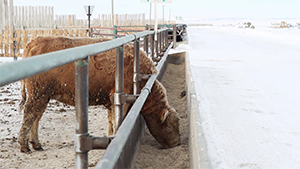Corn Silage in Backgrounding Diets

This article written by Dr. Reynold Bergen, BCRC Science Director, originally appeared in the June 2019 issue of Canadian Cattlemen magazine and is reprinted on the BCRC Blog with permission of the publisher.
Recent columns indicated that corn’s potential to produce 50% higher silage (and starch) yields than barley may offset its 30% higher growing costs, provided the right corn hybrid is selected for the local growing conditions, and provided growing conditions cooperate. The higher starch content of corn silage also means that feedlot diets may need to be re-examined. If corn silage is supplying more starch to the diet, perhaps backgrounding diets can feed less barley grain, or maybe cattle can be backgrounded to heavier weights with a shorter grain finishing period, provided growth rates, feed conversion and carcass grade aren’t adversely affected.
Karen Beauchemin of Agriculture and Agri-Food Canada (Lethbridge) recently published a Beef Cluster study examining whether replacing barley grain with corn silage in backgrounding diets impacted animal performance and carcass characteristics (Effects of feeding corn silage from short-season hybrids and extending the backgrounding period on production performance and carcass traits of beef cattle, doi:10.1093/jas/sky099).
What They Did:
Barley and a 2175 corn heat unit (CHU) hybrid corn were seeded near Lethbridge in May 2014 (last 8-year average 2200 CHU). Barley was silaged in July at the soft dough stage. Corn was harvested before the first frost in September. 160 crossbred steers (644lb) were fed one of four backgrounding diets in a small pen study (10 head per pen, 4 pens per backgrounding diet). The experimental backgrounding diets contained (dry matter basis) 60% barley silage or 60% corn silage (40% barley grain-based concentrate), 75% corn silage (25% concentrate) or 90% corn silage (10% concentrate). The silages had very similar particle lengths, barley grain was dry-rolled (processing index = 82%) and all diets contained 13.5% protein. Two pens of each diet were backgrounded to an average weight of 840lbs, and two pens were backgrounded to an average weight of 950lbs. Cattle were fed once daily, and all diets contained Rumensin but not Tylan. Feed left in the bunk was sampled periodically to assess particle size and nutritional value, and steers were weighed every three weeks. All steers were finished on the same diet (91% barley-based concentrate, 9% corn silage; dry matter basis) to an average pen weight of 1544lbs. Carcass data and liver scores were collected.
What They Learned:
Backgrounding performance: Barley silage-fed steers ate the most and grew the fastest, and steers fed 90% corn silage ate the least and grew the slowest, but these differences weren’t great enough to substantially impact feed efficiency or the number of days to reach the target backgrounding end weight.
The proportion of leftover feed particles longer than 8mm increased from 51% to 75% as the level of corn silage in the diet increased from 0 to 75%. This suggests that steers fed higher levels of corn silage were avoiding some of the dietary fiber. In contrast, the proportion of fine particles (shorter than 8mm) fell from 49% to 25% as the level of corn silage increased. This suggests that the steers on the barley silage diet were leaving behind some of the starch.
Finishing performance: Because they weighed more, steers backgrounded to 950lbs had higher daily feed intakes during the finishing period than steers backgrounded to 840lbs. Aside from that, backgrounding diet (silage type or level) and duration (backgrounded to 840 vs. 950lbs) did not affect growth rate, feed intake or feed efficiency during the finishing period. Total days to slaughter and total feed consumption did not differ among backgrounding diet or duration groups.
Carcass characteristics: Steers backgrounded to lighter weights on the 75% corn silage diets were fatter than the steers from any of the other backgrounding diet – weight combinations. This is hard to explain and may have been a chance result. There were no other differences among backgrounding diets or duration in terms of carcass weight, ribeye area or quality grade. Liver abscess scores were not affected by backgrounding diet or duration.
What it Means:
These results were somewhat unexpected. The researchers had expected better performance from the steers fed the corn silage diets, because corn silage usually contains much more starch than barley silage. But in this case the corn silage contained slightly less starch than usual (28% instead of 30% or more), and the barley silage contained more starch than usual (24% instead of 22% or less). This likely clouded the potential treatment differences.
These results are an important reminder of a few basic principles for both cow-calf and backgrounding operations. Growing conditions affect silage quality, especially for corn. On average, corn produces higher energy silage than barley. But very few years are average, and long-term averages can provide a false sense of security. In fact, actual CHUs in Lethbridge have only been “average” in one out of the past eight years, so test your feed! Unexpectedly high-quality feed containing more nutrients than your class of cattle require can be stretched farther by diluting it with lower quality feed. On the other hand, a disappointingly poor feed test result can tell you what nutrients need to be supplemented. There are decision making tools on http://www.beefresearch.ca to help you do this.
The Beef Research Cluster is funded by the Canadian Beef Cattle Check-Off and Agriculture and Agri-Food Canada with additional contributions from provincial beef industry groups and governments to advance research and technology transfer supporting the Canadian beef industry’s vision to be recognized as a preferred supplier of healthy, high quality beef, cattle and genetics.
Click here to subscribe to the BCRC Blog and receive email notifications when new content is posted.
The sharing or reprinting of BCRC Blog articles is typically welcome and encouraged, however this article requires permission of the original publisher.
We welcome your questions, comments and suggestions. Contact us directly or generate public discussion by posting your thoughts below.